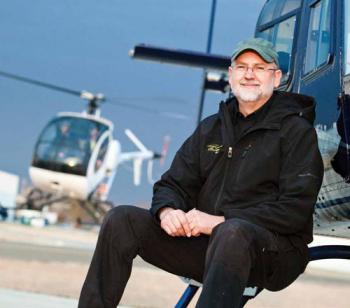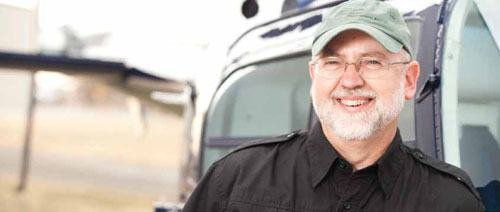
Reed Parsons - DOM for Longhorn Helicopters in Denton, Texas

What can the director of maintenance at a small helicopter operation teach other professional DOMs? Plenty about the value of networking, for one thing.
W. Reed Parsons, 54, is the DOM at Longhorn Helicopters in Denton, TX (KDTO). He oversees a staff of three FAA-certificated airframe and powerplant (A&P) mechanics. The Longhorn fleet consists of six light helicopters—one Bell JetRanger and five two-place piston-powered Schweitzer/Sikorsky 300C aircraft.
Parsons never attended A&P school nor did he earn his DOM position by slowly working his way up a long advancement ladder. He will tell you he is a DOM because of values such as the work ethic he exhibited while learning his trade, his love of the technical side of things and his commitment and willingness to seek and give help where it’s needed.
A history of service
Parsons has only been actively involved in aircraft maintenance for 10 years. Despite an early fascination with airplanes, he traveled a long and winding path before he finally settled into an aviation maintenance career.
Parsons grew up on a family farm in Texas and learned early that repairing and patching was part of life on a farm. “I changed the head gasket on our hay bailer when I was 13,” says Parsons.
Parsons has worked outdoors-type get-dirty jobs such as horse trainer, boat mechanic, dive master, beekeeper and carpenter. He also worked inside jobs including biochemist, software engineer, photographer and isotope-ratio mass spectroscopist.
He cut his teeth and gained the required experience for his A&P certificate through the on-the-job experience as a mechanic’s helper as he worked on a wide variety of turbine and piston aircraft. These aircraft varied from pure jets such as Cessna Citations to radial-engine tail draggers such as Boeing Stearmans at Nebrig and Associates, an aircraft dealership that specializes in turbine and turboprop aircraft sales and is located at the Denton airport.
Parsons has also spent time as a children’s home director where he worked with orphaned, abandoned and troubled youth. He spent two years in Ecuador counseling those affected by alcoholism and drug abuse.
Parsons says that he “gets a charge” out of helping people make positive life changes. He believes the common needs of people are all the same and addressing those needs in the students, other employees at Longhorn and the people he networks with adds to his work.

The importance of networking
Parsons’s belief in the importance of networking and relationships has kept him from needing to apply for a job for 24 years. He says that his varied employment history is an asset and his past adds to his ability to be an effective DOM.
Parsons stresses networking not only for getting his current job but also for successfully following through with the day-to-day DOM responsibilities.
“Aviation is such a small community, especially helicopters that networking really adds up,” says Parsons. He says that one of the most valuable tools for building his network is Heli-Expo, where he takes advantage of the opportunity to talk with other DOMs, exchange tips on how to better maintain the company aircraft, and gather the names and contact information from product and service providers.
“When I need advice and support, the networking I’ve done in the past helps me know who to turn to,” says Parsons.
“I learned a lot from Michael Hornstrom. Most everyone here [at Denton] feels like he is the best guy on the field,” says Parsons, who adds that Hornstrom stressed conscientiousness and high standards. “He taught me to do everything right but also taught me how to do it in a timely manner.”
The high business standards exhibited at Nebrig and Associates and the work standard stressed by Hornstrom and adopted by Parsons has enabled him to transition to the exacting world of helicopter maintenance.
Parsons believes that high standards translate into confidence that flight students sense when they train at Longhorn.
“Flight students are rattled enough as it is — the fact that they know you’re there and you’re checking out everything is so important and you’re listening and have time to explain things matters,” says Parsons.
His attitude toward helping also extends to students and company pilots. “I’m happy as I’m doing stuff to talk them through it,” said Parsons. He has established a policy that requires flight instructors to help out with 100-hour inspections. “That helps them by teaching them where to look for problems, helps them to do a good pre-flight and keeps the fleet safer.”
A First Airplane
Parsons bought a 1956 Piper PA-22 TriPacer while working at Nebrig and Associates. “It was fun and it was pretty,” he says. “It had new fabric and new paint but mechanically ... not so good.” Parsons fixed it up and flew it before selling it to a pilot in Iceland.
Parsons is well on his way to adding a helicopter private pilot license. He has logged more than 500 hours in fixed-wing airplanes as a private pilot with instrument endorsement.
In addition to his helicopter flying, which enables Parsons to conduct pre- and post-maintenance checks on company aircraft, he also logs time in a Cessna 180, which is owned by Dale Williams, co-owner of Longhorn Helicopters.
Parsons had previously worked alongside Williams at Nebrig and Associates while working as a volunteer, restoring historic aircraft at Hangar 10 Flying Museum on the Denton airport.

Williams and Tandy Whitehead are co-owners of Longhorn. Williams will tell anyone that Longhorn provides “the finest helicopter training in the U.S., bar none.” All of the 300Cs are equipped with horizontal situation indictators (HSI) and Garmin 530W for instrument training.
Longhorn Helicopters holds Part 133,135, 137 and 141 certificates from the FAA. The growing use of helicopters by private companies and state and national government agencies and the corresponding need for initial and recurrent training has kept Longhorn helos flying during these uncertain economic times.
Unfortunately, one of the industry’s downsides during the uptick in helicopter usage, especially in the air ambulance side, has been a number of accidents associated with continued operations under marginal weather conditions.
In response to this challenge, operators are turning to night vision goggles (NVG) as one tool to mitigate the accident rate. Longhorn provides NVG training in the company 300C trainers.
“We partnered with Aero Dynamics here in the area to develop a very nice NVG STC for the 300C,” says Parsons. The JetRanger is also equipped with NVG equipment.
What about maintenance challenges associated with operating the piston-powered 300C aircraft during extended training flying in the Texas summer heat? Parsons says that Longhorn has experienced some exhaust valve problems that have been handled by shortening the compliance time with the Lycoming exhaust valve/guide wear and contamination check (wobble test) to 200-hour intervals instead of the bulletin-recommended 300-hour intervals.
Longhorn also takes in outside work in addition to company maintenance.
At the present, maintenance is signed off by one of the staff A&Ps who holds an inspection authorization (IA). Parsons understands the value of a repair station and says the company is slowly working to get up to speed to achieve that goal.
Parsons feels that obtaining the repair station will be a positive move in the maintenance department at Longhorn. “We will have to increase our standards and I like that,” he says.
After all, Parsons says that Longhorn’s co-owners’ commitment to professionalism and quality were “absolutely”a factor in his joining the company.
Parsons knows databases and uses that experience to augment the SCMS maintenance tracking software Longhorn uses to track critical maintenance tasks.
“This helps us stay up with dates and time when maintenance is due. Helicopters are so intense on that,” he says. “You do some repairs but then have to do re-torques at five and 10 hours and the computer helps us keep up with that.”
Maintaining the longhorn legacy
Parsons says he gets a lot of resumes these days but that resumes aren’t his primary resource for finding good help. Networking enables Parsons to find mechanics with a good reputation and good work habits.
At one time Parsons had doubts about the wisdom of becoming an airplane mechanic. He was worried about his ability to always find work. After expressing his doubts to a more experienced technician, he was told that there would always be a place in the industry for someone who is intelligent and doesn’t act like a jerk.
“I look for people who are conscientious about their work and highly into correctness,” says Parsons. He looks for people who fit in well with the rest of the team, but doesn’t have much use for clock watchers or prima donnas. “Airplane mechanics have to be into service,” he says.
